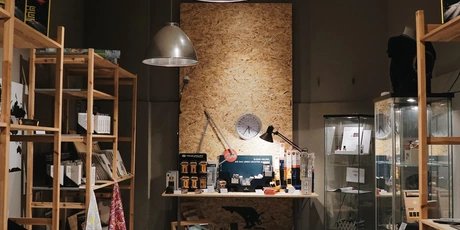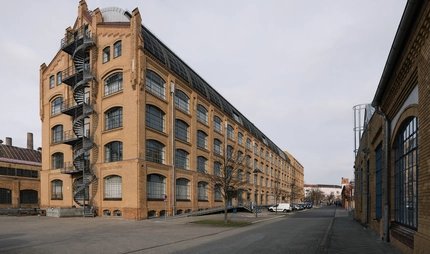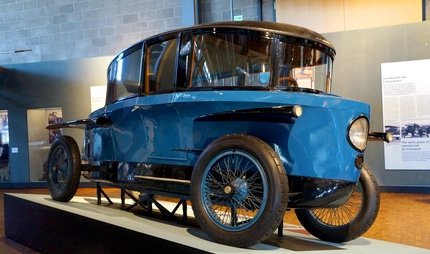
10 Berlin inventions
Innovative 100 years ago, indispensable today
Did you know that these products were invented in Berlin?
Dynamism and change have been a feature of Berlin since its foundation. People move to the Spree River to discover new things and try them out. Some of them succeed in creating something completely new. Many associate the capital primarily with culture, music and exciting nightlife. Less well known is that Berlin has a long tradition of technicians, engineers and inventors.
It is the tinkerers who do not rest until they have finally found the solution to a problem. Today, we use many of their inventions as a matter of course without worrying about their origin. But often there are exciting stories behind their origin.
1855

The advertising pillar (Litfaßsäule)
About one and a half meters in diameter, about 3 meters high and full of posters: advertising pillars are as familiar to every Berliner as the Londoners are to their red telephone booths and the Parisians their Metro station signs.
Because the columns, a revolution in outdoor advertising, are a Berlin invention and shape the streetscape of the capital. In the middle of the 19th century, the creative entrepreneur Ernst Litfaß came up with the idea of erecting so-called "advertising columns" all over Berlin.
Advertising slips and posters dominate the cityscape
Because the city is growing, 800,000 people live on the Spree at that time. Countless events take place and manufacturers of consumer goods try to attract the attention of potential buyers. Both need to be advertised. Even back then, Berliners didn't think much of rules and stuck notes and posters on houses, fences and trees. According to the opinion at the time, this practice led to a "skin disease of the cities", even in the eyes of the Prussian government.
No wonder, then, that Litfaß' proposal is officially supported by the authorities in order to finally get the flood of paper under control. On July 1, 1855, the first 100 advertising pillars adorn the streets of Berlin. Their namesake makes a lucrative business out of it. For ten years he has the sole right to erect advertising pillars. Practically speaking, Litfaß is also the owner of a print shop. He determines the dimensions of his columns so that they display a certain number of his in-house poster formats. In this way, he contributes to the standardization of poster sizes in the Berlin printing industry.
The columns change their appearance over time. At the beginning they are kept simple, but at the turn of the century they have decorative elements such as domes or metal ornaments. From the 1990s onwards, the technology took hold, and now there are also illuminated, rotating columns.
Berlin loses 2,500 advertising pillars
In 2020, Berlin will have to tear down its 2,500 advertising pillars due to asbestos exposure. Only 24 of the original columns are listed and will be preserved. But since outdoor advertising still plays a major role in the 21st century, the number of "advertising pillars" on the Spree will certainly increase again in the future.
By the way: near Alexanderplatz, at the corner of Münzstraße/Almstadtstraße you will find the Litfass Monument. With this replica of a column made of metal, Berlin has set a monument to Ernst Litfaß.
1865

Postcard
"Sunny greetings from vacation" - this or something similar are many of the messages on the postcards that travelers send to their loved ones at home. Even though the number of cards sent is declining in the digital age, they still enjoy great popularity. They show that the sender thought of me, chose a motif and took the time to send the card to me.
A Berlin civil servant wants more efficiency
The history of the postcard in Germany is closely connected with a Berlin official: Heinrich Stephan. The eighth child of a tailor, his success in the Prussian state is not necessarily in his cradle. But through hard work and talent he worked his way up to the position of a Privy Postmaster in the General Post Office in Berlin in the 1850s.
In 1865, at the 5th conference of the German Postal Association in Karlsruhe, he makes the decisive proposal - the introduction of a "Postblatt". A piece of white cardboard, simple, without illustration. But with a stamp already stamped on it. The perfect alternative to the letter, especially for the broad mass of the population: the Postblatt would be easier to send, shorter in content and cheaper.
But the conference topics do not like the idea: should everyone now be able to read the content of a message? "Indecent" is their verdict. Another fear is that postal revenues will collapse if the postage for postal gazettes costs only half as much. His superiors reject Stephan's proposal.
When the so-called correspondence card began to gain acceptance in Austria-Hungary in 1869, the time of the postcard also came in Germany. Heinrich Stephan has meanwhile risen to the position of General Postal Director of the North German Confederation and introduces the card in 1870.
The cards sell like hot cakes - more than 45,000 cards are sold in Berlin even before the new letter form officially comes into force. At that time, however, the Berliners did not write from vacation, but shared everyday things with each other. What they are doing at the moment, when they have time for a meeting - this is how Heinrich Stephan quasi justifies the postal precursor to the text message (SMS).
1881

Electric streetcar
Today, it is impossible to imagine the Berlin cityscape without them: the yellow cars of the streetcar, which today mainly operate in the eastern part of the city. Whether night owls on their way to the club, tourists in search of the most exciting sights or employees at the end of the day on their way home - the 22 lines of the streetcar bring them all safely through Berlin.
The history of this mode of transport is inseparably linked to the capital: the first electric streetcar ran here in 1881 before it began its triumphal procession around the world.
This success is no coincidence, as two of the most common propulsion methods used up to that time have decisive disadvantages.
- Horses, which pulled streetcars on rails in Berlin from 1865 onwards, did not have enough power to pull the carriages uphill.
- Another drawback: their horse droppings pollute the city streets.
- The steam technology used as an alternative, on the other hand, disturbs the inhabitants by the noise and flying sparks.
During this time, Berlin's population continues to grow, and the need for transportation in the city increases.
Werner von Siemens finds the solution
In 1866, the engineer, who had a decisive influence on Berlin from the very beginning with his inventions, succeeded in generating electricity with a direct current motor. This meant that, theoretically for the first time, there was enough energy to power streetcars with an electric motor.
In 1881, after years of tinkering, the maiden voyage of the first electric streetcar takes place in Lichterfelde. With a maximum speed of 2 kilometers per hour, the Siemens cars travel the 2.5-kilometer route between Lichterfelde train station and the Prussian Main Cadet Institute in Lichterfelde West.
After the solution of a number of technical problems, electric streetcar drives finally took hold in 1889 - and paved the way for Berlin's development into a modern metropolis.

You can see a replica of the first electronic Siemens locomotive in the Deutsches Technikmuseum (Museum of Technology).
1891

The first gliding flight
To be able to fly like a bird is an old dream of mankind. Over the centuries, numerous inventors and engineers have been thinking about how it is possible to fly into the air and see the world from above.
As late as 1873, the physicist Hermann von Helmholtz said that a human being could never maintain his own weight at altitude in the long term. On a small hill in the south of Berlin, a man proves that it is possible.
Otto Lilienthal, son of a merchant from Anklam, has dreamed of flying since childhood. He moves to Berlin and becomes an engineer. Together with his brother Gustav, he runs a heating factory in Köpenicker Straße and tinkers on the side with various inventions, including the anchor stone construction kit for children, which is still sold today.
But his great dream always remains flying. Lilienthal observed storks in flight at an early age and thought about the connection between the air currents around the slightly curved wings and lift. In 1889 he published his most important work "The Flight of Birds as the Basis of the Art of Flying". In 1893 Otto Lilienthal produced the world's first serially manufactured aircraft, the normal glider.
The Fliegeberg in Lichterfelde is created
In 1894, he had a 15-meter-high hill, the "Fliegeberg", built in Lichterfelde. From its top, Lilienthal swings himself into the air in more than 2000 flight attempts. In this way he tests whether his self-made constructions are airworthy. He invites the press and, under great public interest, demonstrates a successful gliding flight on June 29, 1895.
Lilienthal's dream costs him his life
Only one year later, his dream cost him his life: on August 9, 1896, Lilienthal crashed during a flight near the town of Stölln and succumbed to his injuries the next day. The flying mountain later becomes part of the Lilienthal Park in Berlin-Lichterfelde. On its top, a bronze globe commemorates one of the most important pioneers in the history of aviation.
1895

Birth of German film in Berlin
"Moving pictures in life size I promised you, a world sensation. And I ask you: Did you get a world sensation?"
This is what the director of the Berlin Varieté Wintergarten asked the 1500 invited guests on November 1, 1895, who had just witnessed the world's first public presentation of moving pictures.
The enthusiasm of the audience speaks for itself: Yes, it was a world sensation. The screening lasts a total of 15 minutes and eight short scenes can be seen. Accompanied by live piano music, the visitors see, among other things, sequences entitled "Italian Peasant Dance" and "Boxing Kangaroo". Watching an event that does not take place in front of the eyes, but only on the screen - there has never been anything like this before.
Behind the sensation are two Berlin brothers, Max and Emil Skladanowsky. Above all Max likes to tinker. His training as a glass painter and his knowledge of photography awaken in him the desire to bring pictures to life. His first forerunners are so-called "fog pictures", which create the illusion of movement by superimposing painted glass plate projections. But the technique has its limits.
Max Skladanowsky searched further and built a double projector in 1895. He perforates the individually shot images and reinforces the holes with shoe eyelets. He calls the apparatus "bioscope" (Greek for life viewer).
After the huge success in the winter garden, the Skladanowskys are euphoric and apply for a patent for the invention. What they do not know at this point: only two months later, on December 28, 1895, another pair of brothers, Auguste and Louis Lumière, present an invention called the cinematograph in Paris. The apparatus is technically superior to the bioscope, as the Skladanowskys admit. Throughout their lives, they argue about the recognition of their services to the beginning of film, both with the Lumières and with the Berlin film pioneer Oskar Messter.
Even if their invention quickly becomes obsolete: on this autumn evening in the Varieté Wintergarten, they are the first to teach the pictures how to walk.
1900
Electric hairdryer
The history of hairstyling is as old as mankind. Long, short, curly, straight - the type of hairstyle has expressed the personality and fashion sense of its wearer for thousands of years. People have come up with countless ways of styling their hair. But for a long time one thing did not succeed: to dry hair faster after washing.
At the end of the 19th century, the first attempts were made to tackle the problem. Porcelain brushes filled with hot water and huge stand-up dryers like the one made by the Frenchman Alexandre Godefroy did not yet offer a solution suitable for the mass market.
Then in 1899 the decisive invention comes from the Berlin company AEG. The company supplies the entire capital with electricity via the Berliner Electricitäts-Werke. AEG's engineers were constantly working on ways to make electricity usable for private consumption. The market for hair dryers for private use offers enormous potential.
AEG's invention, the "hot air shower", is not particularly handy at first - it weighs a hefty two kilograms. At the beginning, AEG advertises the device not only as a hair dryer, but also as a medical device for relieving muscle tension, rheumatism and boils.
The air from the hot air shower is up to 90 degrees hot, which poses a risk of burns. The AEG chronicle celebrating the product's 100th anniversary says of the dryer:
„Ein heißer und ungestümer Kamerad, der damals nur für das mutige Frauchen geeignet war“ ("A hot and boisterous companion, only fit for the brave mistress at the time").
Numerous improvements followed; in the 1930s, women in Berlin used it to style their bobbed heads. From the 1950s onwards, the hairdryer is no longer a luxury product, but a mass product. By this time, it had long since begun its triumphal march around the world.
By the way: as early as 1909, the Berlin company Sanitas registered the brand name "Fön", in reference to the hairdryer, a warm and dry alpine wind. After the takeover of Sanitas in the 1950s, the trademark rights belonged to AEG. The term Fön, which is used synonymously with hair dryer in the German-speaking world, thus strictly speaking describes a product of a Berlin company.
1903
The thermos flask
Hardly any household can do without it - thermos flasks keep hot drinks warm and prevent cold liquids from heating up. This household utensil, used by billions of people worldwide, originally comes from Berlin.
At the beginning of the 20th century, the inventor Reinhold Burger further developed so-called Dewar vessels. The jars, named after their English inventor James Dewar, originally consisted of two glass jars placed inside each other. An air vacuum between the vessels ensures that substances inside are thermally insulated. The problem: Dewar jars are too fragile for transport.
Reinhold Burger builds on this principle. He originally comes from Glashütte, a glassmaking settlement near Berlin. In the capital he did an apprenticeship as a glass technician, so working with the fragile material was in his blood. In 1894 he opened Berlin's first glass instrument factory.
A few years later, Burger hears that ice machine manufacturer Carl von Linde has succeeded in liquefying air. A great leap forward in times when people were increasingly preserving their food by refrigeration. But: liquid air has a temperature of -194.5 degrees and it is extremely difficult to store or transport it. Burger offers from Linde to supply suitable transport equipment.
Burger's jugs are a further development of Dewar's principle. His vessels are made of tempered glass, have a silver coating and a protective metal casing. He wants to test their usefulness for von Linde's business, but does not have liquefied air at his disposal. Instead, he uses cold and hot drinks - which still have almost the original temperature after 24 hours. A useful property that Burger discovers rather incidentally.
In 1904, he registered his vacuum flask with the patent office - brand name "Thermos", after the Greek word for warmth. In 1907, Burger sold the patent to companies in the USA, England and Canada. From here, his invention began its triumphal march around the world.
In the museum village of Baruther Glashütte you can learn more about Reinhold Burger and see original exhibits by the inventor.
1908
Ohropax hearing protection
Berlin at the turn of the century: Machines rattle in the factories, motorised vehicles conquer the streets alongside horse-drawn carriages, the bells and toots are everywhere. For stressed city dwellers, the noise becomes a problem, because sleep is unthinkable in some parts of the city. Not to mention concentrated study and work.
No wonder, then, that various ways are sought to muffle noise: cotton bandages around the head, balls of rubber, metal or felt in the ear canal. All these approaches are still not very satisfactory.
The solution to the problem comes from Maximilian Negwer, a pharmacist from Schöneberg. In Bülowstraße he runs a "factory of pharmaceutical and cosmetic specialities" where cough syrup and homemade creams can be bought. In 1907, Negwer applied for a patent for "Ohropax".
The name says it all: it is a combination of "ear" and "peace" (Latin: Pax). With this brand name, Negwer virtually makes every buyer the promise that they can finally find peace in the midst of noise.
Ohropax are plugs made of synthetic wax that are stretched with Vaseline and cotton. In the ear canal, the wax adapts perfectly to body temperature without melting. It hermetically seals the ear and thus muffles all sounds.
The classically educated apothecary Negwer finds the inspiration for his invention in Homer: in Homer's Odyssey, Odysseus seals his companions' ears with wax to protect them from the sirens' beguiling song.
An idea that also proves extremely useful in modern times. The sensitive literary figure Franz Kafka wrote in a letter: "I couldn't do without earplugs by day or night."
Only a few years after the market launch of Ohropax, its use goes far beyond muffling everyday noise: when the First World War breaks out, many soldiers use the small wax plugs to protect their eardrums from permanent damage - under the advertising slogan
„Hast du Ohropax im Ohr, kommt Dir Lärm wie Stille vor“ ("If you have earplugs in your ears, noise seems like silence").
Even though there are many other earplugs available today, made of foam, plastic or silicone: the original wax earplugs from Ohropax are still one of the most popular products on the noise protection market.
1916

Seamless condom
For the longest time in human history, sex has always been accompanied by certain risks: unwanted pregnancy and the transmission of sexually transmitted diseases. Time and again, there have been attempts to reduce the risk by using barriers made of pig intestines, fish bladders, linen and leather. Both the protection factor and the practicability are limited.
In 1893, the American Charles Goodyear succeeds in vulcanising rubber and thus producing rubber. The material is much more suitable for making condoms than any previously used. But the first proto-condoms consisted of strips of rubber sewn together. The seams scratch and reduce the safety of the product. It remains so-called "stoop goods" that change hands under the counter.
It was not until the beginning of the 20th century that the decisive invention came from Berlin. The rubber manufacturer Julius Fromm produced the first seamless condoms.
Fromm's story bears witness to a true entrepreneurial spirit. The son of poor Jewish immigrants takes evening classes in chemistry to learn about the basics of rubber processing, and in 1914 he founds the first "manufacturing and sales business for perfumeries and rubber goods" in Prenzlauer Berg.
To make the "rubbers", his employees dip glass cylinders in a rubber solution, vulcanise the solution, unroll it and dust it with lubricant - and the first industrially produced condoms are ready.
In 1916, in the middle of the First World War, the inventor launches them on the market under the name "Fromms Act". The timing is perfect: condoms are compulsory in the monitored soldiers' brothels because of the rampant syphilis. Fromm's product sells like hot cakes and in 1919 his company is already producing 150,000 condoms a day.
After the war, sexual morals loosened in Berlin in the 1920s, and "Frommser" became synonymous with condoms, immortalised in cabaret songs like "Wenn's euch packt, nehm Fromm's Act" (If it grabs you, take Fromm's Actor) or "Fromms zieht der Edelmann beim Mädel an" (Fromms the nobleman dresses with the girl).
Julius Fromm's invention can hardly be overestimated in its social and medical-historical significance. All the more tragic that the National Socialists force him to sell his company in 1938 for a ridiculous price and flee to England.
There he at least lived to see the end of the war, dying a few days later on 12 May 1945. Today, a Stolperstein at Friedrichshagener Straße 38 in Köpenick commemorates Julius Fromm.
1930

Charlottenburger Chaussee 109
13597 Berlin
marian@ich.ms
www.marian-stefanowski.de
Television
Even in the digital age, it is still the Germans' favourite pastime: television. An important contribution to its genesis comes from Berlin.
At the beginning of the 20th century, there are two relatively new entertainment media: film, which is still limited to cinema screenings, and radio, which allows people to listen to broadcasts at home via radio waves. The question is: is there a way to also watch moving pictures via a device at home? And even to follow an event live while it is happening?
Hamburg-born tinkerer Manfred von Ardenne sets out to find a solution to the problem. He already had his first experience with the technology of radio receivers. He develops an improved version of the Braun tube for the Loewe company. At a young age, this earned him enough money to buy a villa with a laboratory in Berlin-Lichterfelde. A visit to the International Radio Exhibition there in 1928 inspired him. He sees apparatuses that transmit images by mechanical means, based on the technique of another Berliner by choice, the technician Paul Nipkow. The images are about the size of a postcard, blurred and out of focus.
Von Ardenne searches for a way to control the image transmission electronically instead. The most important component of his television set is a Braun tube that can produce a focused, steerable electron beam. This beam draws a line-shaped zigzag pattern on the luminous screen, thereby creating many isolated pixels that the human eye assembles into an image. From 25 frames per second, the brain no longer perceives the images as isolated, but as a moving film. Von Ardenne's invention has many advantages: the resolution is higher and the image is bigger and brighter than with mechanical transmissions. Another important point is the lower production costs.
Electronic television quickly begins its triumphal march in the 1930s. The National Socialists also recognised the propaganda potential of the new medium. They use it to broadcast the Olympic Games in Berlin in 1936. After the Second World War, television quickly becomes the most important mass medium of the 20th century.



